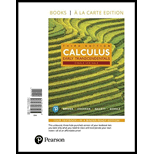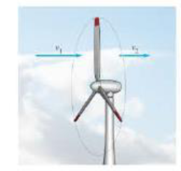
Concept explainers
Efficiency of wind turbines A wind Turbine converts wind energy into electrical power. Let v1 equal the upstream velocity of the wind before it encounters the wind turbine, and let v2 equal the downstream velocity of the wind after it passes through the area swept out by the turbine blades.
a. Assuming that v1 > 0, give a physical explanation to show that
b. The amount of power extracted from the wind depends on the ratio
Calculate R(1) and explain how you could have arrived at this value without using the formula for R. Give a physical explanation of why it is unlikely or impossible for it to be the case that r = 1.

c. Calculate R(0) and give a physical explanation of why it is unlikely or impossible for it to be the case that r = 0.
d. The maximum value of R is called the Betz limit. It represents the theoretical maximum amount of power that can be extracted from the wind. Find this value and explain its physical meaning.
Want to see the full answer?
Check out a sample textbook solution
Chapter 4 Solutions
Single Variable Calculus Format: Unbound (saleable)
- Question 2 Let F be a solenoidal vector field, suppose V × F = (-8xy + 12z², −9x² + 4y² + 9z², 6y²), and let (P,Q,R) = V²F(.725, —.283, 1.73). Then the value of sin(2P) + sin(3Q) + sin(4R) is -2.024 1.391 0.186 -0.994 -2.053 -0.647 -0.588 -1.851 1 ptsarrow_forward1 pts Let F and G be vector fields such that ▼ × F(0, 0, 0) = (0.76, -9.78, 3.29), G(0, 0, 0) = (−3.99, 6.15, 2.94), and G is irrotational. Then sin(5V (F × G)) at (0, 0, 0) is Question 1 -0.246 0.072 -0.934 0.478 -0.914 -0.855 0.710 0.262 .arrow_forwardanswerarrow_forward
- 1. Given the vector field F(x, y, z) = -zi, verify the relation 1 VF(0,0,0) lim +0+ volume inside S ff F• Nds S. where S, is the surface enclosing a cube centred at the origin and having edges of length 2€. Then, determine if the origin is sink or source.arrow_forwardLet a = (-4, 5, 4) and 6 = (1,0, -1). Find the angle between the vector 1) The exact angle is cos 2) The approximation in radians isarrow_forwardFind the (exact) direction cosines and (rounded to 1 decimal place) direction angles of = (3,7,6)arrow_forward
- Let a = (-1, -2, -3) and 6 = (-4, 0, 1). Find the component of b onto a.arrow_forwardForces of 9 pounds and 15 pounds act on each other with an angle of 72°. The magnitude of the resultant force The resultant force has an angle of pounds. * with the 9 pound force. The resultant force has an angle of with the 15 pound force. It is best to calculate each angle separately and check by seeing if they add to 72°.arrow_forward= Let (6,2,-5) and = (5,4, -6). Compute the following: บี.บี. บี. นี = 2 −4(u. v) = (-4). v= ū. (-40) (ū. v) v =arrow_forward
- Algebra & Trigonometry with Analytic GeometryAlgebraISBN:9781133382119Author:SwokowskiPublisher:Cengage
 Algebra: Structure And Method, Book 1AlgebraISBN:9780395977224Author:Richard G. Brown, Mary P. Dolciani, Robert H. Sorgenfrey, William L. ColePublisher:McDougal Littell
Algebra: Structure And Method, Book 1AlgebraISBN:9780395977224Author:Richard G. Brown, Mary P. Dolciani, Robert H. Sorgenfrey, William L. ColePublisher:McDougal Littell College Algebra (MindTap Course List)AlgebraISBN:9781305652231Author:R. David Gustafson, Jeff HughesPublisher:Cengage Learning
College Algebra (MindTap Course List)AlgebraISBN:9781305652231Author:R. David Gustafson, Jeff HughesPublisher:Cengage Learning 
 Functions and Change: A Modeling Approach to Coll...AlgebraISBN:9781337111348Author:Bruce Crauder, Benny Evans, Alan NoellPublisher:Cengage Learning
Functions and Change: A Modeling Approach to Coll...AlgebraISBN:9781337111348Author:Bruce Crauder, Benny Evans, Alan NoellPublisher:Cengage Learning Algebra and Trigonometry (MindTap Course List)AlgebraISBN:9781305071742Author:James Stewart, Lothar Redlin, Saleem WatsonPublisher:Cengage Learning
Algebra and Trigonometry (MindTap Course List)AlgebraISBN:9781305071742Author:James Stewart, Lothar Redlin, Saleem WatsonPublisher:Cengage Learning





